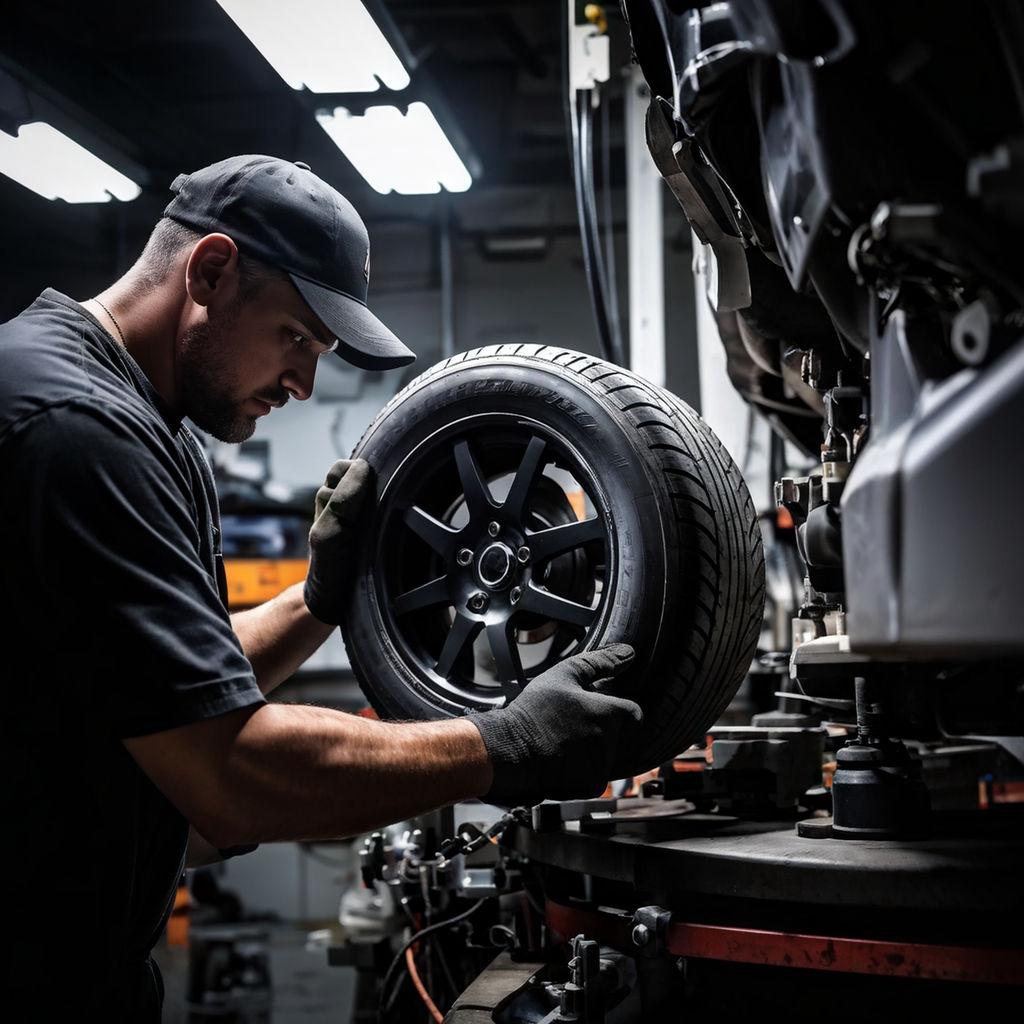
- Key Takeaways
- Understanding Tire Balance and Alignment
- What Is Tire Balancing
- Signs Your Tires Need Balancing
- What Is Wheel Alignment
- Signs Your Car Needs Alignment
- Benefits of Proper Balance and Alignment
- Tire Balance vs. Alignment
- Maintenance Tips
- Final Remarks
- Frequently Asked Questions
Did you know that improper tire alignment causes around 30% of premature tire wear? Understanding tire alignment and balancing is crucial for maintaining your vehicle’s performance and safety. Tire alignment ensures your tires are angled correctly, promoting even wear and optimal handling. On the other hand, tire balancing helps distribute weight evenly across all tires, preventing vibrations and ensuring a smooth ride. By grasping these concepts, you can extend the lifespan of your tires, improve fuel efficiency, and enhance overall driving experience. Let’s delve into the world of tire maintenance and discover how alignment and balancing play a pivotal role in keeping your vehicle in top condition.
Key Takeaways
- Proper tire balancing and alignment are crucial for a smooth and safe driving experience.
- Regularly check for signs indicating the need for tire balancing, such as uneven tire wear or vibrations.
- Look out for symptoms like steering wheel pulling to one side or uneven tire wear as indicators for wheel misalignment.
- Ensure to maintain correct tire pressure and rotate tires regularly to prolong their lifespan.
- Remember that tire balance focuses on equal weight distribution, while alignment adjusts the angles of the wheels for optimal performance.
- Schedule routine maintenance checks to keep your tires in top condition and prevent premature wear.
Understanding Tire Balance and Alignment
Tire Balancing
Tire balancing is the process of equalizing the weight distribution of a tire and wheel assembly. During the tire rotation process, each tire and wheel are removed, inspected, and reattached in a different position to ensure even wear. This procedure helps prevent uneven tire wear, vibration, and potential steering issues.
Balancing tires involves attaching small weights to the wheel to offset any heavy spots. When a tire is imbalanced, it can cause vibrations that are felt through the steering wheel or the vehicle’s seat. These vibrations can lead to discomfort for passengers and can also affect the overall handling of the vehicle.
Wheel Alignment
Wheel alignment, on the other hand, refers to adjusting the angles of the wheels so that they are perpendicular to the ground and parallel to each other. This adjustment ensures that the vehicle drives straight without pulling to one side. Proper tire assembly is crucial for maintaining alignment, as misaligned wheels can cause uneven tire wear and affect steering control.
Correct tire weights play a significant role in balancing tires. If the weights are not placed accurately or if they fall off, it can result in imbalanced tires. Imbalanced tires can lead to premature wear on certain parts of the tire, reducing its lifespan and compromising safety.
Regular maintenance for tire balance and alignment is essential to ensure optimal vehicle performance. By balancing tires and aligning wheels, drivers can experience smoother rides, improved fuel efficiency, and enhanced safety on the road. Neglecting these maintenance tasks can result in uneven tire wear, decreased fuel economy, and compromised handling.
What Is Tire Balancing
Tire Balancing Process
When it comes to tire balancing, it involves using a tire balancing machine to ensure that the weight of the wheel and tire is evenly distributed. This process helps in eliminating any heavy spots on the tire, which can cause vibrations while driving. First, the technician will mount the tire on the machine and spin it to determine where the imbalances lie. Then, small weights are strategically added to the rim to counterbalance these irregularities, ensuring a smooth rotation.
Impact on Vehicle Safety and Performance
Improperly balanced tires can have a significant impact on both vehicle safety and performance. When wheels are not balanced correctly, it can lead to vibrations that are felt throughout the car, especially at higher speeds. These vibrations not only result in a less comfortable ride but also affect steering control. Moreover, imbalanced wheels can cause uneven tire wear, reducing the life of the tires and potentially leading to costly replacements sooner than expected.
Preventing Excessive Tire Wear and Vibration Issues
Tire balancing plays a crucial role in preventing excessive tire wear and vibration issues. By ensuring that the weight distribution is uniform across all wheels, tire balancing helps in maintaining proper contact between the tires and the road surface. This, in turn, promotes even tread wear and extends the overall life of the tires. Balanced tires reduce vibrations, resulting in a smoother and quieter driving experience for vehicle occupants.
Signs Your Tires Need Balancing
Uneven Wear
Uneven tire wear is a clear indicator that your tires need balancing. If you notice uneven wear on the edges or center of the tire, it’s likely due to imbalanced tires.
Steering Vibrations
When you feel vibrations in the steering wheel, it could be a sign of unbalanced wheels. These vibrations can indicate that your tires are not evenly distributing weight.
Maintenance After Flat Tire Repair
After a flat tire repair, it’s essential to check if your tires need balancing. The process of repairing a flat tire can sometimes lead to an imbalance in the wheel balancing.
Regular Check-Ups
Regularly scheduling a tire balancing service can prevent issues like tire wobbling and ensure that your tires are in optimal condition. It helps maintain balanced tires for a smoother driving experience.
Car Tremors
Specific tremors in your car, especially at high speeds, can suggest the need for balancing machine services. These tremors often point towards imbalanced wheels, affecting the overall stability of your vehicle.
What Is Wheel Alignment
Suspension Adjustment
Wheel alignment refers to the adjustment of a vehicle’s suspension system, ensuring that aligned wheels are at the correct angles as specified by the manufacturer. This process involves adjusting the alignment settings of each wheel assembly to ensure they are perpendicular to the ground and parallel to each other.
Tire-Road Contact
Proper wheel alignment is crucial as it ensures optimal tire-road contact, enhancing vehicle stability and handling. When the wheels are correctly aligned, the tires make uniform contact with the road surface, promoting even tire wear and extending tire life.
Preventing Issues
Maintaining regular wheel alignment helps prevent steering issues and uneven tire wear. Misaligned wheels can lead to bent wheels and vibrations in the steering wheel, affecting the vehicle’s overall performance and safety. By aligning the wheels correctly, drivers can enjoy a smoother ride and improved fuel efficiency.
Signs Your Car Needs Alignment
Pulling to One Side
One of the most common indicators that your car needs alignment is when it pulls to one side while driving. This could be due to misaligned wheels, causing uneven tire wear and affecting the vehicle’s stability on the road.
Squealing Tires
Another sign of potential alignment issues is squealing tires. When your tires are not properly aligned, they can create excessive friction with the road surface, leading to unusual noises while driving.
Off-Center Steering Wheel
An off-center steering wheel is a clear indication of steering alignment problems. If you notice that your steering wheel is not straight when driving straight, it could be a result of misaligned wheels.
Alignment problems can arise from various factors such as accidents or road conditions. Even minor collisions or hitting potholes can knock your wheels out of alignment, impacting how your car handles on the road. Uneven road surfaces and rough terrain can also contribute to misaligned wheels over time.
Timely alignment is crucial to prevent further damage to your vehicle. Ignoring alignment issues can lead to uneven tire wear, reduced fuel efficiency, and compromised safety while driving. Regular alignment checks can help maintain optimal performance and prolong the lifespan of your tires.
Benefits of Proper Balance and Alignment
Extended Lifespan
Proper wheel alignment benefits your vehicle by extending the lifespan of your tires, ultimately saving you money. When your tires are aligned correctly, they wear out more evenly, reducing the need for frequent replacements.
Balancing services play a crucial role in maintaining the longevity of your tires. By ensuring that the weight is distributed evenly across all four tires, you prevent premature tire tread wear. This balance reduces the strain on individual tires, helping them last longer.
Improved Vehicle Handling
Alignments not only benefit your tires but also enhance your overall driving experience. With the right alignment, your vehicle’s steering response improves significantly. This means smoother handling and better control, especially when navigating sharp turns or rough terrain.
Proper balance and alignment lead to significant performance enhancements in your vehicle. When your wheels are aligned correctly, you experience improved fuel efficiency as the tires encounter less resistance on the road. A balanced wheel assembly reduces vibrations, providing a smoother ride for you and your passengers.
Tire Balance vs. Alignment
Tire Balance
Tire balance focuses on the distribution of weight around a tire and wheel assembly. When a tire is mounted onto a wheel, it may not be perfectly balanced, leading to imbalance. This imbalance can cause vibrations in the steering wheel and uneven tread wear. To address this issue, tire balance services use balance weights to ensure even weight distribution.
Improper tire balance can result in accelerated tire wear, affecting the overall tire life. Uneven tread wear is a common consequence of imbalance, which can lead to the need for premature tire replacement. By addressing balance issues promptly through regular tire balancing, drivers can extend the lifespan of their tires and maintain a smoother driving experience.
Wheel Alignment
Alignment refers to the adjustment of the angles of the wheels to ensure they are perpendicular to the ground and parallel to each other. Unlike tire balance, which focuses on weight distribution, alignment issues primarily affect vehicle handling and steering response. Proper alignment helps prevent excessive tread wear by ensuring that the tires make optimal contact with the road surface.
When wheels are out of alignment, vehicles may exhibit symptoms such as pulling to one side, uneven tire wear, or steering wheel vibration. These issues not only impact driving comfort but also compromise safety. Regular alignment checks and adjustments can help correct these problems and enhance overall vehicle performance.
Importance of Both Services
Both tire balancing and wheel alignment are crucial for maintaining overall vehicle performance. While tire balance services focus on reducing vibrations and extending tire life, alignment services ensure proper vehicle handling and steering response. Neglecting either of these services can lead to safety hazards, increased fuel consumption, and premature tire wear.
- Proper tire balance extends tire lifespan.
- Correct wheel alignment enhances vehicle handling.
- Neglecting either service can result in safety risks.
Maintenance Tips
Regular Maintenance
To maintain tire balance and alignment, it is crucial to schedule regular wheel maintenance. This includes tire rotations every 5,000 to 7,000 miles to ensure even wear and optimal performance.
Professional Inspections
Seeking professional services from skilled technicians is essential for detecting issues like flat spots or misalignments early on. Technicians use specialized equipment like a wheel alignment machine to make precise adjustments.
Early Detection
Regular inspections can help in the early detection of problems that might affect tire balance and alignment. By catching issues early, you can prevent further damage to your tires and ensure a smoother ride.
Final Remarks
Now that you understand the importance of tire balance and alignment, you can ensure your vehicle’s optimal performance and safety. Regular maintenance and being mindful of the signs that indicate issues with balance or alignment can save you money in the long run by preventing uneven wear and tear on your tires. By following these tips, you can extend the lifespan of your tires and enhance your driving experience.
Take charge of your vehicle’s maintenance today by scheduling a tire balance and alignment check. Your safety on the road and the longevity of your tires depend on these simple yet crucial steps. Keep your car running smoothly and efficiently by staying proactive with balance and alignment maintenance.
Frequently Asked Questions
What is the difference between tire balance and alignment?
Tire balancing ensures even weight distribution on each tire, preventing vibrations. Wheel alignment adjusts the angles of the wheels to ensure they are perpendicular to the ground and parallel to each other, promoting even tire wear and proper vehicle handling.
How do I know if my tires need balancing?
Signs include steering wheel vibrations, uneven tire wear, and increased road noise. Regular balancing helps maintain smooth driving, extends tire life, and improves fuel efficiency.
When should I get a wheel alignment?
It’s recommended to have your wheel alignment checked every 6,000 miles or if you notice uneven tire wear, steering pulling to one side, or a crooked steering wheel. Proper alignment enhances safety, improves handling, and prolongs tire lifespan.
What are the benefits of proper tire balance and alignment?
Proper balance and alignment promote even tire wear, improve fuel efficiency, enhance vehicle handling and safety, reduce vibrations, and extend the lifespan of your tires. Regular maintenance ensures optimal performance and a smoother driving experience.
How can I maintain proper tire balance and alignment?
Regularly check tire pressure, rotate tires every 6,000-8,000 miles, avoid hitting potholes or curbs, and schedule routine wheel alignments. Following these maintenance tips will help preserve the balance and alignment of your tires for better performance and longevity.


